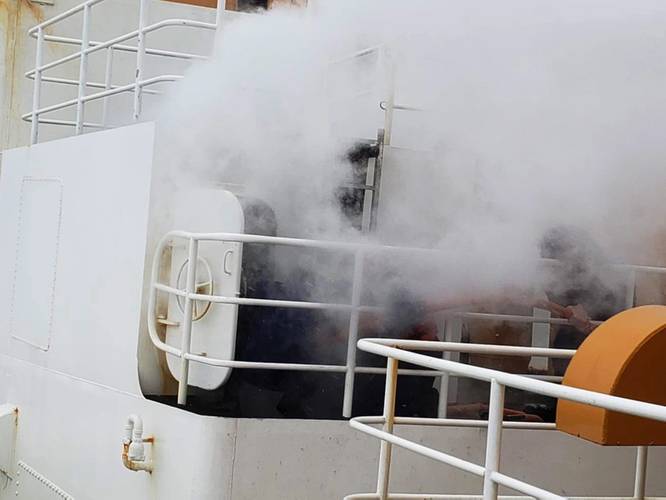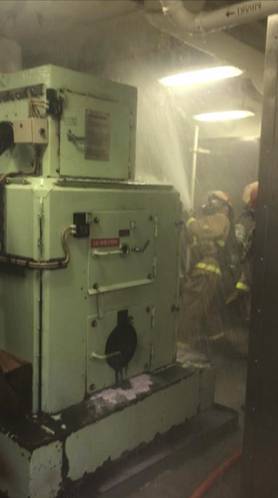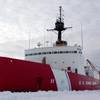Fire Breaks out on USCG's Polar Star
It seems the U.S. cannot do enough to fast-track the construction of its new icebreaking fleet, as the USCG announce last night that the 150-member crew of the U.S. Coast Guard Cutter Polar Star fought a fire at approximately 9 p.m. PST Feb. 10 that broke out in the ship's incinerator room about 650 miles north of McMurdo Sound, Antarctica.
After initial response efforts using four fire extinguishers failed, fire crews spent almost two hours extinguishing the fire. Fire damage was contained inside the incinerator housing, while firefighting water used to cool exhaust pipe in the surrounding area damaged several electrical systems and insulation in the room. Repairs are already being planned for the Polar Star’s upcoming maintenance period. The incinerator will need to be full functional before next year’s mission.
No injuries were reported, and the cause of the fire is under investigation.
“It’s always a serious matter whenever a shipboard fire breaks out at sea, and it’s even more concerning when that ship is in one of the most remote places on Earth,” said Vice Adm. Linda Fagan, commander of the U.S. Coast Guard’s Pacific Area. “The crew of the Polar Star did an outstanding job – their expert response and determination ensured the safety of everyone aboard.”
Commissioned in 1976, the 43-year old ship is operating beyond its expected 30-year service life. The Polar Star crew recently completed Operation Deep Freeze, an annual joint military service mission in support of the National Science Foundation, the lead agency for the United States Antarctic Program. Since 1955, U.S. Indo-Pacific Command has assisted in providing air and maritime support throughout the Antarctic continent.
This year marks the 63rd iteration of the annual operation, and the Polar Star crew departed their homeport of Seattle Nov. 27 for their sixth deployment in as many years and travelled more than 11,200 miles to Antarctica.
Upon arrival, the Polar Star broke nearly 17 miles of ice, six to ten feet thick, in order to open a channel through McMurdo Sound. Once complete, the crew refueled at McMurdo Station, the United States’ main logistics hub in Antarctica. The ship also provided a six-hour familiarization cruise in McMurdo Sound to 156 randomly selected station personnel.
On Jan. 30, the Polar Star escorted the container ship Ocean Giant through the channel, enabling a 10-day offload of nearly 500 containers with 10 million pounds of goods that will resupply McMurdo Station, Amundsen-Scott South Pole Station and other U.S. field camps.
The Feb. 10 fire was not the first engineering casualty faced by the Polar Star crew this deployment. While enroute to Antarctica, one of the ship’s electrical systems began to smoke, causing damage to wiring in an electrical switchboard, and one of the ship’s two evaporators used to make drinkable water failed. The electrical switchboard was repaired by the crew, and the ship’s evaporator was repaired after parts were received during a port call in Wellington, New Zealand.
The ship also experienced a leak from the shaft that drives the ship’s propeller, which halted icebreaking operations to send scuba divers into the water to repair the seal around the shaft. A hyperbaric chamber on loan from the U.S. Navy aboard the ship allows Coast Guard divers to make external emergency repairs and inspections of the ship’s hull at sea.
The Polar Star also experienced ship-wide power outages while breaking ice. Crew members spent nine hours shutting down the ship’s power plant and rebooting the electrical system in order to remedy the outages.
Presently, the U.S. Coast Guard maintains two icebreakers – the Coast Guard Cutter Healy, which is a medium icebreaker, and the Polar Star, the United States' only heavy icebreaker. If a catastrophic event, such as getting stuck in the ice, were to happen to the Healy in the Arctic or to the Polar Star near Antarctica, the U.S. Coast Guard is left without a self-rescue capability.
By contrast, Russia currently operates more than 40 icebreakers – several of which are nuclear powered.
















